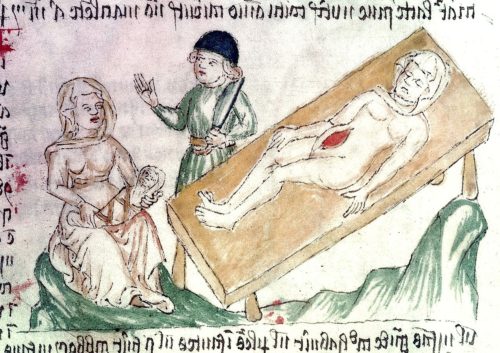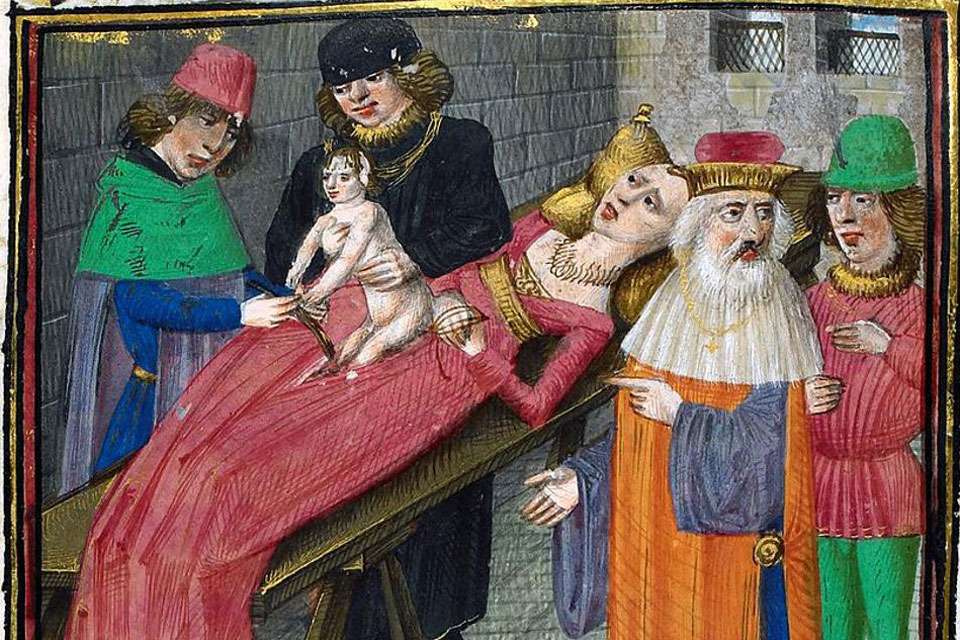New Czech study raises the question whether a caesarean section was successfully carried out in Prague in the 14th century.

Nowadays, caesarean sections are performed on numerous hapless women across the world even though natural births ought to be the norm. Thus more than 50% of Turkish woman have sections performed while only 15 – 16% of the women in Northern Europe undergo this treatment. Yet only 2 – 4‰ of infants die up North, while 11,1‰ die in Turkey (OECD 2014). This is particularly worrisome, since it is generally agreed that “Caesarean delivery continues to result in increased maternal mortality, maternal and infant morbidity, and increased complications for subsequent deliveries, as well as increased financial costs, raising questions about the appropriateness of some caesarean delivery that may not be medically required.” (OECD 2013)
One of the intriguing questions lying behind this status quo is how something as “normal” as giving birth to a child at least in some places moved from the sheltered private sphere to a clinical theatre characterised by white tiles, steel, and people dressed in green alien-looking outfits?
Naturally, this is a vast subject, which has been explored by a number of historians. In general, the conclusion is that this shift began to take place in 15th century Southern Europe, where male practitioners increasingly took over obstetrics at a time when social stratification hardened and the need to procure male progeny became increasingly vital. The future of medicalization of birth was at that point well under way. It is perhaps not a coincidence that it is around this time a number of elaborate royal chronicles begin to focus on the myth about the birth of Julius Caesar. It is an interesting hypothesis that this myth of Caesar’s birth helped the idea along that safe births might be secured through male medical interventions.
Nevertheless, at this point, caesarean section of children was if not the norm, at least a known and important procedure primarily aimed at securing the baptism of the child and presumably – at least occasionally – its life when the mother had already died; the so-called sectio in mortuo.
It is obvious that at some point some mothers may have survived this procedure and reports are known from the beginning of the 16th century. The first certain survival dates from 1610, when the child was reported to have lived 9 days, while the mother survived for 25 days. From the end of the 18th century and the beginning of the 19th reports of survivals seem to increase, but whether this just reflects the increased volume of sources is a matter for discussion. In general, though, the survival of the mother seems to have depended on three factors: the practice of not just sewing up the abdomen, but also the uterus, the use of antiseptics, and finally, the use of anaesthesia. It was not until after WW2 it became a common procedure used in a wider health care sontext.
Beatrice of Bourbon

Recently (2016) a group of medical doctors together with a historian, all from Charles University in Prague, have reported on the possible survival of a mother and a child undergoing a caesarean section in 1337.
Beatrice of Bourbon (1320 – 1383) was the second wife of the John the Blind, king of Bohemia and Duke of Luxemburg (1296 – 1346). In 1337 she gave birth to Wenceslaus I (1337 – 1383).
The basis for this understanding comes from the formulation in two letters, sent to inform the public about the birth of the son. In these she tells that she gave birth to a son “salva incolumitate nostri corporis” – which has been translated into: “such that the soundness of our body is not damaged” (or perhaps rather: without any calamities or harm to our body).
The point is thus that the letters without doubt stress that she came to no harm during the birth of the child. It took place without any harm being caused to her – and her future capability to give birth again.
Why would she write that? Later chronicles from the beginning of the 15th century famously claimed that the boy had been taken from her body and the wound had healed and compared the delivery with that of Julius Ceasar, mythically rumoured to have been delivered in this way. Later texts claim more emphatically that she had suffered and survived a caesarean section.
The scientists and historians responsible for the study are careful not to claim that this was the case. Nevertheless it is not totally inconceivable that she might have undergone a caesarean and also potentially have survived. Later history shows that this was miraculously the case in a few unique cases in early modern history.
Also, we know from the treatment of Charles IV of Bohemia in 1350 that highly sophisticated surgical operations could be carried through. Specialists, who had trained in Italy, were available at the court at this point. This might also have been the case 13 years earlier.
Obstetric Fistulae
On the other hand, in itself there is nothing in the phrase used, which indicates that a Caesarian had been performed. Quite the contrary.
In fact, it is more reasonable to believe that it must have been generally known in the 13th and 14th centuries that young girls at the age of 13 -17 were susceptible to all sorts of illnesses like those which hit adolescents in Africa today – especially obstetric fistulae. The letter might simply have been intended to lay down public rumours as to the health of a very young queen and her future capabilities of carrying again.
However, as we all know there is no smoke without a fire. And indeed, that something happened might also be indicated by the fact that even if Beatrice remarried at the age of 27 with Eudes VI de Grancey – with whom she lived until he died in 1389 – she carried no further children. It is probably also pertinent in this case that this Eudes belonged to a not very prominent family, the Seigneurs de Grancey. At this point, she (a crowned queen) seems to have been treated as damaged goods.
It seems likely that the letters were meant to keep these sordid details from the public; just as was the case 13 years later, when the step-brother of her son, the future Holy Roman Emperor, Charles IV, hid the exact character of the mutilation, which he suffered as a consequence of jousting and which later anatomical studies marred his future public appearance.
Multiple Hypotheses
The Czech scientists and historians write in their conclusion that ” it is not possible to unequivocally determine whether a caesarean section that was survived by both the mother and child was actually performed in the 14th century. From a medical standpoint in the context of all the known surrounding circumstances, however, this rare event could indeed have taken place”.
Nevertheless, a more sober conclusion – although just as hypothetical – is that the birth was indeed full of complications and that rumours in the following days spread in the city of Prague that the queen was damaged as to her future breeding capabilities; hence the letters he wrote.
Finally, a third option is that nothing happened, but that rumours nevertheless spread causing the queen to repudiate them as best she could.
As it is, we shall probably never know. But the scientists and historians from Czechia should be congratulated on publishing this interesting case.
SOURCE:
Prague 1337, the first successful caesarean section in which both mother and child survived may have occurred in the court of John of Luxembourg, King of Bohemia
By A. Pařízek, V. Drška, M. Říhová et al.
In: Česká Gynekologie, 2016, 81, č. 4, p. I–X
READ ALSO:
The result of the research carried out by the group from Charles University was afterwards noted in an article in in New York Times:
A Breakthrough in C-Section History: Beatrice of Bourbon’s Survival in 1337.
By Hana de Goeij.
In NY Times, 23.11.2016
This led to a lively debate on diverse mailing lists plus some critical comments voiced by Monica Green concerning the lack of references in the original article to the relevant literature published in English. Afterwards she published a Bibliography on Academia. edu:
On Caesarian Section in the Middle Ages
By Monica Green
In a number of other comments published by Monica Green, she has voiced a more critical position concerning the (presumed) lack of peer editing of the original article in Česká Gynekologie as well as a vivid critique of Newspapers publishing popular science articles and thus spreading non-valid information (fake news) about research.
Who Knows Anything? – Journalism, Caesarean Section, and the Production of Knowledge. The New York Times ran a story about an amazing c-section survival in 1337. But historians of medieval medicine don’t think it happened.
By Monica H. Green
Posted on the blog: How did we get into this mess, by David M. Perry.
Finally, an article in Forbes recounts the story of the debatw, which was caused in English-speaking media concerning the published article:
Historians Question Medieval C-Section ‘Breakthrough,’ Criticize New York Times Coverage
By Kristina Killgrove
In: Forbes 13.12.2016
As a comment to this debate it may perhaps be proper to make a few points: First of all Česká Gynekologie is not an “obscure” Czech journal, but a well regarded peer-reviewed journal, albeit outside the somewhat myopic American circuit. Although the article can be criticised for its lack of correct dealing with the analysis of the historical sources and the lack of references to the core literature in English, it – on the other hand – lists publications, which are not part of this American circuit. Finally, the article is the result of interesting work carried out at the Carl’s University in Prague focusing on the medical milieus in Italy, France and Southern Germany in the 14th century, not least witnessed by the interesting studies of the events surrounding the illness of Charles IV in 1350 and the surgical procedures, which were carried it in connections with this (as witnessed by anatomical studies of his remains).
READ MORE:
FEATURED PHOTO:
Medieval depiction of Caesarean birth. c. 1473-1476. (Image from the British Library, Royal MS 16 G VIII f.32r. Source: Wikimedia Commons



